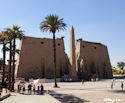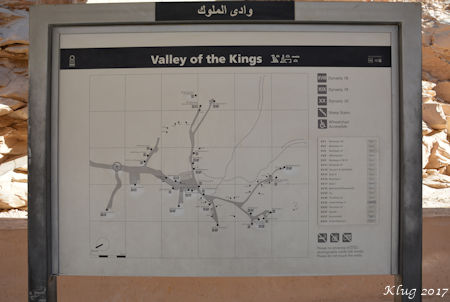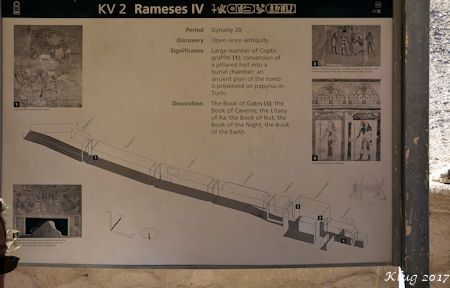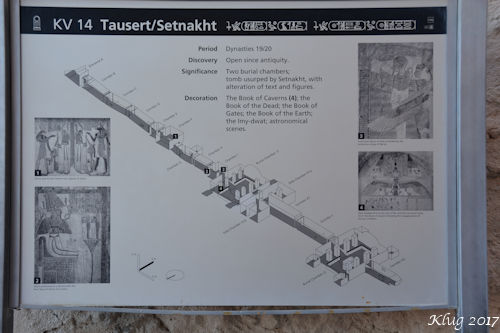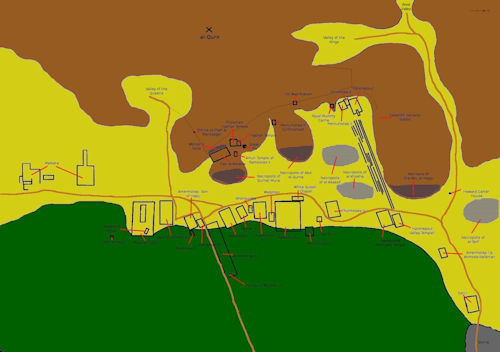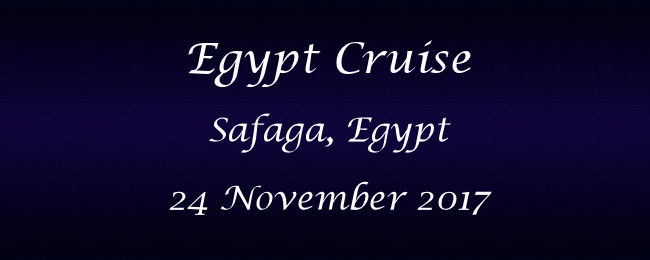
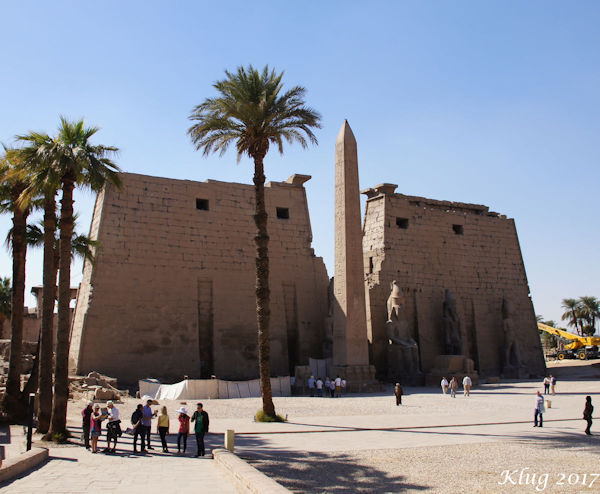
Photo by Carey Klug
Links to Port Pages
Safaga, Egypt
![]()
Incredible day in Egypt - Luxor and Valley of the Kings. Here is a summary from Randy!
Luxor
After transiting the Suez Canal, a stop at Sharm el Sheihk, and a wonderful stop at Aqaba, Jordan to visit Petra, we returned to Egypt across the Red Sea and stopped at Safaga. Safaga for our cruise was the gateway to Luxor and the Luxor Temple and the Valley of the Kings. We set out for Luxor in the early morning and had about a three hour bus ride to Luxor. Luxor in ancient Egypt was called Thebes or even further back known as Waset. Waset was the capital of ancient Egypt from approximately 1550 to 1100 BC. Luxor today is the home of the well-known and famous Egyptian temples of Luxor and Karnak. Unfortunately we weren’t able to visit Karnak, but it was a choice between the temple at Luxor and longer time in the Valley of the Kings or Karnak and a shorter time at the temple at Luxor and Valley of the Kings. Kind of a “no win situation”, so we went with longer time in the Valley of the Kings. Either way it was a six hour round trip from Safaga to Luxor and back.
Luxor Temple
Luxor Temple was believed to be the site where pharaohs of the era were crowned. There is even some historical records that indicate that Alexander the Great was crowned king in the Luxor Temple, but other records show he may not have traveled that far south into Egypt. There is evidence that the pharaoh Tutankhamun (1332-1323 BC) may have been crowned at the Luxor Temple and he certainly made additions to the temple during his short reign. It was a chance to get up close to several carvings and it was amazing to see the precision they were able to accomplish back then. We also saw and photographed murals that were added during the Roman period.
Luxor Temple - The temple was built by Amenhotep III (1390-52 BC), completed by Tutankhamun (1336-27 BC) and Horemheb (1323-1295 BC). It was added to by Rameses II (1279-13 BC). At the back is a granite shrine dedicated to Alexander the Great (332-305 BC). |
Remaining Obelisk - there once were two! |
Another view of the Obelisk |
Up close view of the hieroglyphs |
Pylons and Rameses II |
Tutankhamun and wife |
Walking through the columns to the Court of Rameses II |
Column details |
Column Hieroglyphs |
Randy in the Court of Rameses II |
Papyrus Columns
|
Court of Rameses II |
Looking back to entrance of the court |
View of the back wall of the pylon tower |
Mosque of Hajjij built on top of the temple |
Information sign about Court of Rameses II |
Rameses II |
Carey at base of Rameses II |
Amenhotep III Colonnade |
Papyrus column detail |
Court of Amenhotep III |
Statuary |
Roman era painting over the original Egyptian decorations |
Entry to Hypostyle Hall which includes the AMun Santuary, chapels, a Shrine to Amenhotep, and then rebuilt with a chapel for Alexander the Great |
Birth room |
Amun Sanctuary walls |
Columns - can still see the decoration |
Up close view |
Detail view in sanctuary |
Luxor Temple rendering from Mark Millmore - site Discovering Ancient Egypt |
Temple |
Avenue of the Sphinxes |
One of the sphinxes |
Our first view of the Avenue from the bus as we traveled through Luxor heading to the temple |
Valley of the Kings
An amazing stop and almost worth the whole trip! Valley of the Kings was incredible. Unlike the visits at the Giza Plateau or Petra, the Valley of the Kings was immaculate, clean, and quiet. You had to run a small gauntlet of souvenir sellers at the main entrance but once you were in the valley itself it was quiet, clean, and almost reverent. Amazingly it felt very uncrowded and left to my own I could have wandered for hours in the valley.
You can visit several of the open tombs in the valley. The count seems to change periodically based on what repair and conservation work is being done, but there are approximately 10 to 12 tombs open to the public. A couple of catches here. Not all of these tombs are open at the same time. Not counting the tomb of Tutankhamun only six tombs are open on any given day. I assume they rotate those based on exposure to the elements, limiting the impact of visitors, and staff limitations. The further limitation is that your admittance ticket only allows you to visit three tombs not counting Tutankhamun’s tomb which requires an additional fee but is still counted in your three tomb limitation. I’m guessing you could go back and buy a second admission ticket and visit another three tombs but we had limited time and I didn’t ask or check to see if that was possible.
I’m still not totally sure we did the right thing but we decided not to buy the extra ticket and visit Tutankhamun’s tomb. I’ve seen dozens and dozens of pictures over the years of Tut’s tomb and we had to balance that out against dropping one of the other tombs. The Egyptologist escorting us really recommended we visit the three tombs she’d picked out as she thought they were the best open in the valley that day. She also said Tutankhamun’s tomb was really quite rudimentary in comparison to the others. She reminded us that Tutankhamun apparently died well before he was expected to and that his tomb had not been completed. Indeed his tomb actually may have been initially started for another unknown royal and was hastily converted for his burial.
I do want to point out a big change that has been made in the Valley of the Kings. For an additional fee you are now allowed to take non-flash pictures inside all the tombs with the exception of Tutankhamun where no photography is permitted. This is a recent change made in early November 2017 and in fact it had only been allowed a matter of a week or so when we visited. Many tombs still had the “No Photography Allowed” signs up. To that point the photographs below are ours.
A little note about the numbering the Valley of the Kings tombs. While there have been a number of different numbering systems over the decades today they are numbered in the order that they were discovered, not where they are in the valley itself. At present there are 64 suspected or known tombs with the valley number KV 1 through KV 64 with a possible unverified KV 65 still be explored.
KV 2 Rameses IV
This is the first tomb we visited. While the tomb was robbed in antiquity the first known recording of the tomb was made in 1718 with the first detailed mapping and plan being done in 1737-38 by Richard Pococke. Rameses IV ruled Egypt from approximately 1155 to 1149 BC. Because of his father’s long 31 year reign Rameses IV was in his forties when he ascended to the throne and had a relatively short reign. Luckily other than the damage done by the initial tomb robbers and graffiti left from visitors, Rameses IV tomb has escaped the flood damage experienced by many of the other tombs and is in relatively good condition. Preservation has mostly been patching cracks and holes, cleaning of the painted surfaces, installation of lighting, glass protective walls, and wooden walk ways. I hope the pictures below catch some of the incredible colors and decorations. It was another one of those “take your breath away” moments when we first entered the tomb.
Walking into the valley |
Randy - Finally here! |
KV 2 Map |
Entering into KV2, first section of the tomb |
Second section |
Third section - Sarcophagus room |
Detail view |
Last section |
Detail |
Detail |
Hieroglyphs
|
Ceiling painted with stars |
KV 11 Rameses III
Rameses III reigned from 1186 to 1155 BC. KV 11 was actually started for the Pharaoh Setnakht (1189-1186 BC) but ran into another tomb (KV 10) and was abandoned. Sethnakht was eventually buried in KV 14 after evicting the burial of the queen pharaoh Tausert. Digging was apparently restarted and the descending corridor takes a turn to the right and then down again to avoid KV 10. Like many of the tombs in the valley this was robbed in antiquity. I have no exact date for the first recorded visit but the tomb was mapped and planned by Pococke in 1737-38. This tomb is huge and has remarkable reliefs and paintings but has suffered some damage from the periodic floods in the valley. Like KV 2 there has been some preservation attempts and it is well worth the visit as the pictures below show.
KV 11 Map |
Entering the first section of the tomn |
Extraordinary! If you look to the end you can see where the tomb takes a right hand turn to avoid KV10 |
Niches in the walls |
Niches in the walls |
Information about the intersection of KV10 |
Moving into the second section there are four "cutouts" on each side |
Details are incredible |
Incredible decoration |
and more |
Entire wall with a traverse story of Rameses
|
Longer view in the third section of the tomb |
Fourth section with niches above as the tomb descend farther down |
Rameses paying tribute to Osiris |
Information on the decorations in the tomb |
More paintings in the last section accessible |
 |
|
Ceiling |
Long view of ceiling in the second section |
KV 14 Tausert/Sehakht
This is a very interesting tomb. Not only is it substantial and extremely well decorated but it has quite a story albeit an incomplete one. The background, as best I understand it and as best it is understood, is that Tausert was Seti II’s queen. On Seti II’s death Tausert somehow declared or became the Pharaoh and reigned from 1193-1190. This apparently wasn’t well received or recognized as subsequent Pharaohs did not recognize her as being a Pharaoh. This seems to be backed up by the fact that when Setnakht’s initial tomb in the Valley of the Kings ran into another it was abandoned and Tausert’s tomb was appropriated and extended significantly for his burial. It’s a little gray about exactly what happenend to Tausert but her granite sarcophagus was apparently recently discovered in another tomb in the valley for a different person. My uneducated guess is her mummy was evicted and the tomb and whatever was identified with her was changed, modified, or reused.
So back to Sehakht. Interestingly he only ruled from 1189 to 1186 BC but because of taking over Tausert’s tomb he has one of the largest and amazing tombs in the valley. Like most tombs in the Valley of the Kings it was robbed in antiquity so you can only guess, using Tutankhamun’s tomb as a yardstick, it most have been magnificent. It is substantial and well decorated as shown below.
KV 14 Map |
Entering the tomb |
First wide area, Section E |
Detail Hieroglyphs |
Section E (Fourth level) |
Detail view |
Section J arched ceiling |
View of other side wall |
Full view |
Sarcophagus level (Section M) |
Detail carving
|
Sarcophagus |
Detail carving |
Detail of the underside of the sarcophagus lid |
Ceiling in Sarcophagus room |
Wall inscriptions |
Closer view |
Looking back up the tomb |
Carving of Pharoah being carried away |
Anubis paintings |
As Randy shared above, we had to make a choice on the tombs to visit and chose to bypass on Tutankhamen. But we did walk by it and saw where it is located!
King Tut's tomb which we did not visit, but were told it was simple and not very spectacular due to his short life |
The map of King Tut's tomb |
Hatsphepsut’s Mortuary Temple
Hatsphepsut is probably most known as the woman who would be Pharaoh. Early scholars gave her credit for being co-regent with the young Thutmose III, but more recently evidence is that she took on and reigned as Pharaoh from 1479 to 1458 BC. Interestingly during this time she even went to the extent of having statues carved reducing her female attributes and of herself wearing a beard. Some records show her and Thutmose III joint ruling, but other records list him as the general of her armies. It should be noted that a woman being pharaoh was not totally unique and there are records of several female pharaohs before Hatsphepsut but somehow she seems to be the best known. It is apparent when Thutmose III took the throne after her death he went about defacing or removing her name and likeness from several monuments including her own mortuary temple. Unfortunately we were unable to get up to the temple. As often happens with tours we were on a tight schedule to get back to Safaga and the ship and simply ran out of time.
This is probably as good a place as any to mention while the Valley of the Kings was generally reserved for pharaohs, queens, and a few other high ranking officials the rest of the court and nobles didn’t want to be far away. We weren’t able to visit the tombs but the whole area outside and including the Valley of the Kings is considered to be the Theban Necropolis. There are something like 14 mortuary temples for the likes of Rameses II, Seti I and of course Hatsphepsut. With the exception of Hatsphepsut’s temple, only a little remains of the other mortuary temples. The ravages of time and being located in the Nile flood plain has reduced most, even the once very substantial Ramesseum (Rameses II’s temple), to mostly unrestored ruins. I don’t know the number of tombs of in the hills just outside of the Valley of the Kings but just based on casual observation from the bus as we whizzed by it has to be in the hundreds. Some are nothing more than empty caves while a few are supposedly elaborately decorated and have been restored and can be visited. Again, you could probably spend days, weeks, and months in just the Luxor area and not see it all.
Hatsphepsut Temple |
Zoom in view Hatsphepsut Temple |
Colossi of Memnon
After we departed the temple we drove back through the Theban Necropolis, past what we now know were numerous mortuary temples and sites for various pharoahs. The map below is from wikipedia.org
So reading more about the Colossi I found the best simple description to be on wikipedia -
"The Colossi of Memnon are two massive stone statues of the Pharaoh Amenhotep III, who reigned in Egypt during the Dynasty XVIII. For the past 3,400 years (since 1350 BC), they have stood in the Theban Necropolis, located west of the River Nile from the modern city of Luxor.
The twin statues depict Amenhotep III (fl. 14th century BC) in a seated position, his hands resting on his knees and his gaze facing eastwards (actually ESE in modern bearings) towards the river. Two shorter figures are carved into the front throne alongside his legs: these are his wife Tiy and mother Mutemwiya. The side panels depict the Nile god Hapy.
Both statues are quite damaged, with the features above the waist virtually unrecognizable. The southern statue comprises a single piece of stone, but the northern figure has a large extensive crack in the lower half and above the waist consists of 5 tiers of stone. These upper levels consist of a different type of sandstone, and are the result of a later (Roman Empire) reconstruction attempt. It is believed that originally the two statues were identical to each other, although inscriptions and minor art may have varied.
The original function of the Colossi was to stand guard at the entrance to Amenhotep's memorial temple (or mortuary temple): a massive construct built during the pharaoh's lifetime, where he was worshipped as a god-on-earth both before and after his departure from this world. In its day, this temple complex was the largest and most opulent in Egypt. Covering a total of 35 hectares (86 acres), even later rivals such as Ramesses II's Ramesseum or Ramesses III's Medinet Habu were unable to match it in area; even the Temple of Karnak, as it stood in Amenhotep's time, was smaller." (from Wikipedia)
Colossi of Memnon - Twin Statues of Amenhotep III |
East (or North) assembled from 5 tiers of stone |
West (or South) from a single piece of stone |
Randy at the Colossi |
After the short stop visiting the Colossi, our bus returned to Luxor and a small hotel on the Nile River for afternoon tea. It was a lovely place to rest and refresh before the long drive back to the ship. During our stop the sun began to set and we saw a beautiful sunset with Nile RIver and the Valley of the Kings as our backdrop.
Walking back down to the shuttle to the visitor center |
Valley of the Kings |
Howard Carter's house |
Amenhotep III Mortuary Temple - restored statues of Amenhotep III and wife |
Traveling through Luxor |
Panoramic view of the Nile from the hotel |
Looking across the Nile to the Valley of the Kings |
Sailing Feluccas |
Feluccas |
Carey joins the "band"! |
Sunset on the Nile |
Entry tickets |
And after 3 and 1/2 hours on the bus again, we arrived back at the pier and the ship just prior to sail away! We were tired, thirsty, excited, and awed by our day. Thank goodness the next days would be sea days and we could rest and reflect on all that we had seen in Egypt.
The words are actually hard to find to describe the feelings and emotion of our days in Egypt after the dreams of nearly a lifetime. We could have spent so much more time there, and we see now there is much we have missed. However, we accomplished our dream and touched the pyramids at Giza, stood in the shadow of the Sphinx, crossed the Nile, walked the path of those from thousands of years ago into the Valley of the Kings, gazed upon the statues in the temple at Luxor, and saw the sun set across the valley and the river. Incredible memories.
![]()
Pre-cruise Post
Our fifth port of call on the cruise is Safaga, Egypt. There is not much in the area. In fact the description in Wikipedia is very simple - "Port Safaga, also known as Safaga, is a town in Egypt, on the coast of the Red Sea, located 53 km (33 mi) south of Hurghada. This small port is also a tourist area that consists of several bungalows and rest houses."
Why stop here???? This is a "gateway" to Luxor and the Valley of the Kings!
We are booked for the tour !
Discover the ancient treasures of Egypt during this scenic and memorable, full-day excursion to Luxor.
Luxor Temple
Depart the pier for the approximate 3.5 to 4 hour drive to Luxor. Upon arrival, your first stop is at the spectacular Luxor Temple. The original temple complex was built during the New Kingdom on the site of an older sanctuary. Over the centuries, various rulers made additions that included statues, chapels, a colonnade and a sun court. Ramses II added a statue of himself and a pair of 82-foot (25-metre) obelisks; one of them was taken to Paris in 1835, and today stands in the Place de la Concorde.
Lunch and the Valley of the Kings
Next, re-board your coach and proceed for a buffet lunch at a 5-star deluxe Hotel. After lunch, drive across the Nile to the West Bank for a visit to the Valley of the Kings. During a period of 500 years from the 16th to 11th century B.C., tombs were constructed in this Theban Necropolis for the kings and powerful nobles of the New Kingdom.
The 'wadi' consists of two valleys, the East Valley, where the bulk of the royal tombs are situated, and the West Valley. To date, 63 tombs have been discovered, with chambers ranging in size from a simple pit to a complex tomb with over 120 chambers. Most of the tombs were cut into the limestone, and took six years to complete, depending upon their size. The most notable tomb discovered in the valley is that of King Tutankhamun, as it includes a display of the young king's mummified body. A visit to King Tutankhamun's tomb is not included but can be arranged in advance.
Queen Hatshepsut Temple
Following your visit, a photo stop is made at the mortuary temple of Queen Hatshepsut, which is dramatically perched at the head of a valley overshadowed by the peak of the Thebes. Queen Hatshepsut was the fifth pharaoh of the 18th dynasty of Ancient Egypt. Egyptologists generally regard her as one of the most successful pharaohs, reigning longer than any other woman of an indigenous Egyptian dynasty.
Colossi of Memnon
A final photo stop is made at the Colossi of Memnon, a pair of colossal statues standing alone in a farmer's field. The statues are all that remains of the Temple of Amenhotep III. From here, drive back across the Nile to the East Bank and enjoy an afternoon tea at a 5 stars deluxe restaurant, then commence the approximately 3.5 to 4 hour drive back to the pier.
For guests wishing to visit King Tutankhamun's tomb, there is an additional cost of USD $15.00 cash and can be arranged with your guide, however must be arranged en route to the Valley of the Kings. Photography inside the Valley of the Kings is prohibited.
![]()
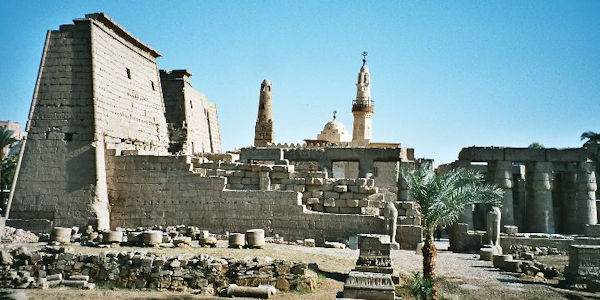 |
Luxor - Photo by Hajor on Wikipedia |
.png) |
Sketch Map of East Valley of the Kings. Original version taken from Egyptian Antiquities in The Nile Valley, published in 1932, by James Baikie (1866-1931). Taken from the english Wikipedia Modified to show location of KV63. Topographgic lines added For the correct locations of all graves on the map please see de:Template:Tal der Könige (Ost) - from Wikipedia |
![]()
If you'd like to look for your own cruise click here -![]()
![]()
